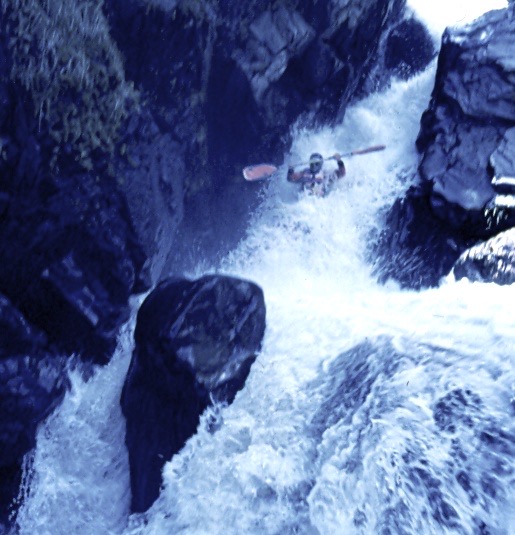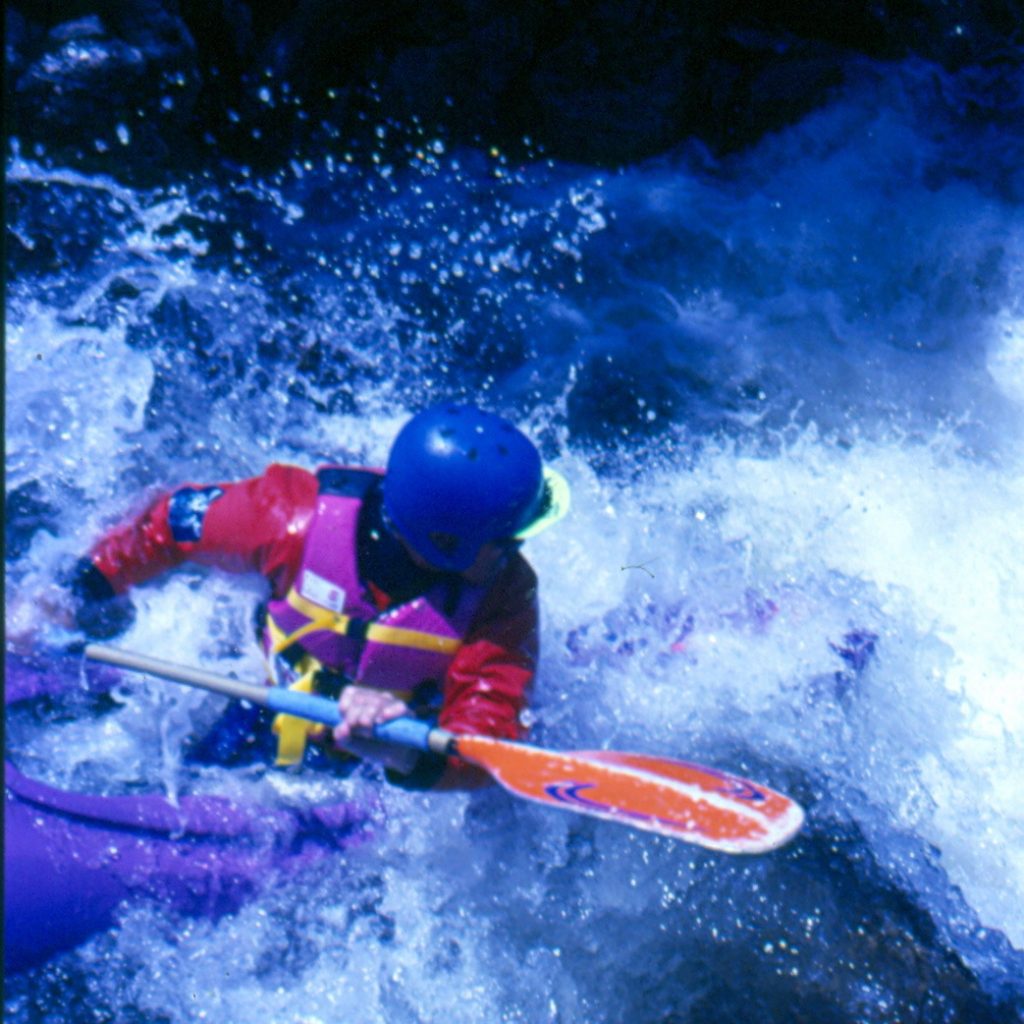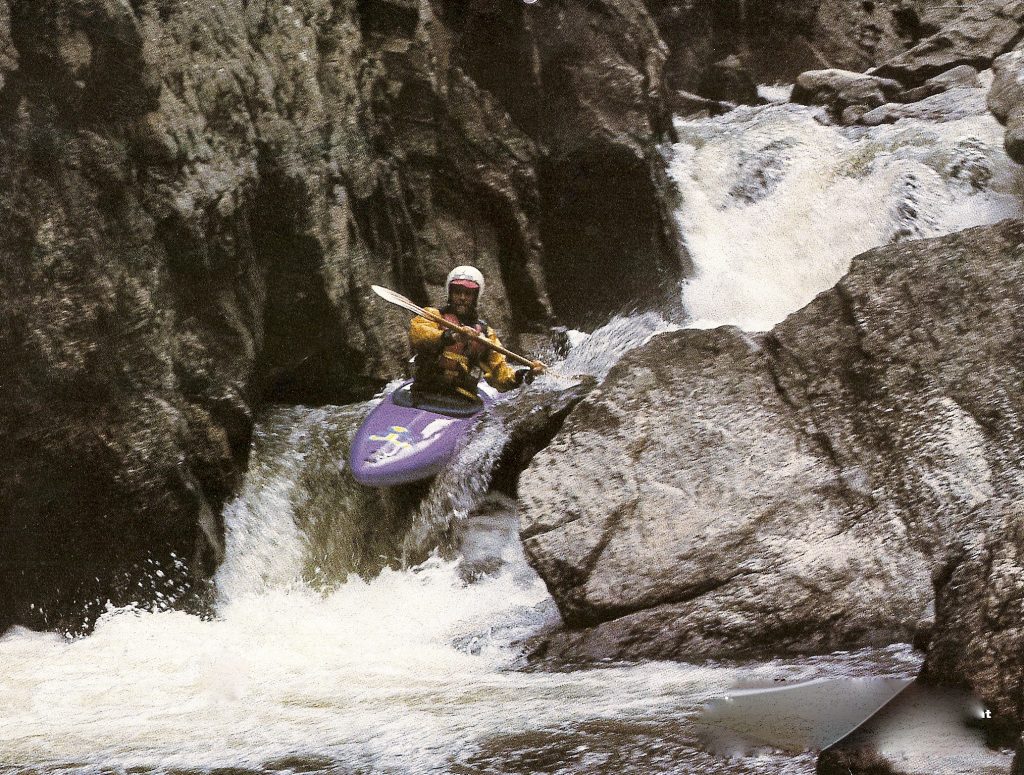




“The worst of all fears is the fear of living.”
— Teddy Roosevelt, from An Autobiography, 1913
THE TOLTEC GORGE
“I think I may have found another good river,” Landis said, as we shared a few beers after a run on Boulder Creek. “This one is down by the New Mexico border. It has a couple of steep sections, but there is an old narrow gauge train for access, and it could be a classic.”
We carefully studied a few maps together and started to organize an expedition. Since access to water gauge info wasn’t computerized yet, and we couldn’t get any stats on the Toltec, we took a chance on mid-June and headed south.
The only obvious takeout was a cattle guard next to a “No Trespassing” sign on a dirt road in the middle of nowhere. It was quite easy to find, but the logistics for the put-in were a lot more challenging. It involved finding, and traveling on, a rough road that traversed a very large ranch. One of the ranch workers had never met a kayaker before, but he gave us permission to look for the put-in.
The lonely road finally ended at an old railroad station, where a tiny tributary meandered down a steep valley to the Rio de los Pinos. The small tributary had barely enough water to float a boat and was infested with dense brush, but it was quite exciting and definitely better than dragging the boats.
The main creek was running at about 500 cfs, which seemed like a perfect level as we eddy scouted the first drop — a remote Class IV canyon.
“Wow! This might be the new classic run in Colorado!” Landis said enthusiastically, but his euphoria only lasted a few minutes. The next corner revealed an extremely steep canyon with a raging torrent of pure white heading off the edge of a cliff.
We had stopped to scout on river right, and the only reasonable choice was a Class V ferry back to the left side of the river, where we hoped to find a trail back to the train track. Missing the ferry would have probably been fatal, so we picked the best line and paddled hard. We all managed to make the moves, and then we scouted as far downstream as we could before the left bank turned into a sheer cliff.
“It’s probably OK at really low water,” Landis said, as we stared in awe at the raging torrent.
The only escape route involved climbing a very steep hillside and pulling our boats up to the old railroad track. It was a warm day, and the boats were heavy, but we struggled upward until we finally reached the flat terrain of the track. From there, it was an easy boat drag back to the truck, and our exhausted group ran back to Boulder with our tails between our legs.
About a month later, we were bouncing our way down a very bony Clear Creek, and the Toltec suddenly came to mind.
“This river is getting way too low, so the Toltec should be perfect now. Let’s go try again,” Landis proposed.
I was eager to go, but Sascha, who was the third member of the first team, would have nothing to do with the whole adventure. So we recruited Pete Heller, Mark Lane, and David Eckardt and headed back down to the New Mexico border.
We met the caretaker of the ranch on a narrow dirt road.
“¡Hola amigo! Where are you going?” Garcia asked.
“We are planning to kayak the canyon,” Landis replied.
“Wow! That’s just a bunch of waterfalls. I go fishing down there sometimes, and I think it’s impossible. There is one place where you can’t even walk, and there is a big waterfall. I’ve never seen kayaks here before,” Garcia said, astonished.
“We were here about a month ago, and it was way too high,” Landis continued. “But the water is a lot lower now, and I think we can do it.”
“I think that you’re really crazy, but good luck. This is a private ranch, but I don’t think that my boss will care if you use this road. Be careful! It’s a long way to the nearest hospital.”
The water was much lower now, but we decided to spend the rest of the afternoon trying to scout the steepest part of the gorge from the narrow gauge track that had been carved into the steep canyon walls.
“That’s where we hiked out last time,” I said, pointing to the sharp left turn where the river suddenly disappeared over a small cliff. The raging torrent of pure whitewater had been reduced to a reasonable stream, and portaging the falls looked possible. The gradient seemed to ease after the falls, but we couldn’t see the gorge from our current viewpoint.
“We should be able to get a view of the lower canyon from the top of the falls, but it looks like it gets easier,” Landis said optimistically.
The day was waning, and a thorough scout would be very difficult, so we set up camp at the old train station in the middle of nowhere. The tourist train that travels from Chama, New Mexico, to Antonito, Colorado, had already made its passage for the day, and the small ghost village was empty.
A large herd of elk grazed on a nearby hillside, and a small flock of swallows swarmed around the many leaks that dripped from an old wooden tank, that was still used for the train. We enjoyed a great dinner in this remote paradise and watched the stars erupt in the dark sky after a brilliant sunset.
The tiny creek that we had used for access on the first attempt was now dry, so we had to drag our boats down the brushy gulch to the river. The spectacular Class IV stretch that we had run at high water had been reduced to a boney Class III, but the gorge below was at a perfect level. The reasonable stream flow made it possible for us to scout and run most of the drops.
Mark Lane had spent a summer in Corsica, where the art of steep creeking was in the process of being invented, and he had developed a new perspective about what was possible in a kayak.
“Wow! I can’t believe that you’re going to run that!” Pete said, amazed. Everyone but Mark stared at the rapid we were scouting, a drop that defied our current standards of reason.
“I did one like this in Corsica last summer. It’s not as bad as it looks,” Mark assured us, as he climbed into his boat. It looked really bad to the rest of the group, but he seemed very confident, so we rushed to set up safety and readied our cameras.
The rapid started with two, ten-foot waterfalls that led into a nearly vertical chute that dropped about twenty-five feet into a very small pool. This was followed immediately by another fifteen-foot cascade.
Mark nailed the first three drops, but the small eddy upset his balance. A strong brace kept him upright, but his spray skirt popped, and he was forced to run the fifteen-foot drop backwards with a boat full of water. The heavy boat slammed into a rock, which compressed the stern. But Mark escaped without injury, and his boat wasn’t severely damaged. He actually made it look fairly easy, but he was about ten years ahead of his time, and there was plenty more action downstream, so everyone else portaged.
A few somewhat more reasonable drops brought us to the brink of a very serious waterfall. We were able to climb around it using ropes, but it would have been extremely difficult at high water. I have since talked to a fellow extreme boater from New Mexico named Joel Serra, who ran it at high water with a very solid team. They had a very epic day, but they all somehow survived without injury.
The gradient eased a bit after the big falls, and we entered a breathtaking, sheer-walled gorge that we named Lolita’s Dream. This section had some beautiful Class Vs and was the most enjoyable paddling of the trip. But the good whitewater ended way too soon, leaving us with an arduous portage around a wood- and brush-infested sieve.
We managed to bounce through another mile of shallow creek before the gradient eased and the river widened. This section was way too shallow at low water, but we managed to push and scrape our way to a private bridge, where two local fishermen were sipping martinis. They were very surprised to see us.
The steepest section is extremely dangerous at high water and the lower half of the run is too much of a shallow scrape at low water, so I don’t think this will ever be a classic. However, the canyon is really spectacular and adventuresome boaters would probably find it worth the effort. I would strongly recomend about 200 CFS or even less.
